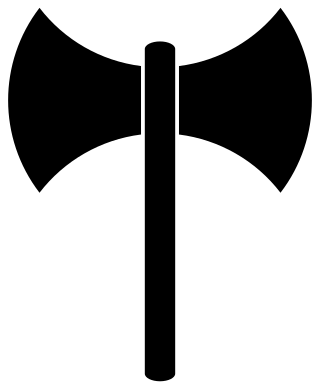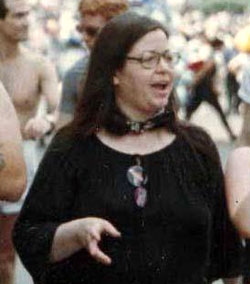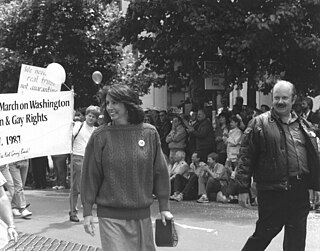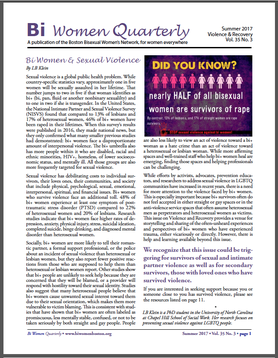| Founded | February 1972 |
|---|---|
| Location |
National Bisexual Liberation Group was a bisexual rights advocacy organization formed in 1972 in New York City and active in the 1970s.
National Bisexual Liberation Group was founded in New York City in February 1972 by Don Fass, a New York psychotherapist. [1] [2] [3] [4]
By winter of 1975, the organization claimed it had more than 5,500 members in ten chapters across the United States, 800 members in their New York City chapter, and that more than 4,000 people had attended their New York City events. [1] [4]
The organization had chapters around the United States, published a newsletter, and advocated on bisexual rights. [1] [4]
In 1974-1975, the organization held monthly parties and weekly group meetings. The organization also hosted occasional brunches and coffee socials. [4]
The organization published a newsletter, The Bisexual Expression, considered by some to be the earliest newsletter specifically for the bisexual community in the United States. [1] [4]

Lesbian, gay, bisexual, and transgender (LGBT) movements are social movements that advocate for LGBT people in society. Although there is not a primary or an overarching central organization that represents all LGBT people and their interests, numerous LGBT rights organizations are active worldwide. The first organization to promote LGBT rights was the Scientific-Humanitarian Committee, founded in 1897 in Berlin.

The homophile movement is a collective term for the main organisations and publications supporting and representing sexual minorities in the 1950s to 1960s around the world. The name comes from the term homophile, which was commonly used by these organisations. At least some of these organisations are considered to have been more cautious than both earlier and later LGBT organisations; in the U.S., the nationwide coalition of homophile groups disbanded after older members clashed with younger members who had become more radical after the Stonewall riots of 1969.

Lesbian feminism is a cultural movement and critical perspective that encourages women to focus their efforts, attentions, relationships, and activities towards their fellow women rather than men, and often advocates lesbianism as the logical result of feminism. Lesbian feminism was most influential in the 1970s and early 1980s, primarily in North America and Western Europe, but began in the late 1960s and arose out of dissatisfaction with the New Left, the Campaign for Homosexual Equality, sexism within the gay liberation movement, and homophobia within popular women's movements at the time. Many of the supporters of Lesbianism were actually women involved in gay liberation who were tired of the sexism and centering of gay men within the community and lesbian women in the mainstream women's movement who were tired of the homophobia involved in it.

LGBT culture is a culture shared by lesbian, gay, bisexual, transgender, and queer individuals. It is sometimes referred to as queer culture, while the term gay culture may be used to mean "LGBT culture" or to refer specifically to homosexual culture.

Brenda Howard was an American bisexual rights activist and sex-positive feminist. The Brenda Howard Memorial Award is named for her.
The bisexual community, also known as the bi+, m-spec, bisexual/pansexual, or bi/pan/fluid community, includes members of the LGBT community who identify as bisexual, pansexual, omnisexual, polysexual and sexually fluid. As opposed to hetero- or homosexual people, people in the bisexual community experience attraction to more than one gender.

Robyn Ochs is an American bisexual activist, professional speaker, and workshop leader. Her primary fields of interest are gender, sexuality, identity, and coalition building. She is the editor of the Bisexual Resource Guide, Bi Women Quarterly, and the anthology Getting Bi: Voices of Bisexuals Around the World. Ochs, along with Professor Herukhuti, co-edited the anthology Recognize: The Voices of Bisexual Men.

The Second National March on Washington for Lesbian and Gay Rights was a large political rally that took place in Washington, D.C., on October 11, 1987. Its success, size, scope, and historical importance have led to it being called, "The Great March". It marked the first national coverage of ACT UP, with AIDS activists prominent in the main march, as well as making headlines the next day during mass civil disobedience actions at the United States Supreme Court Building.
LGBT movements in the United States comprise an interwoven history of lesbian, gay, bisexual, transgender and allied movements in the United States of America, beginning in the early 20th century and influential in achieving social progress for lesbian, gay, bisexual, transgender and transsexual people.
This is a list of notable events in the history of LGBT rights that took place in the 1970s.

Getting Bi: Voices of Bisexuals Around the World is an English anthology edited by Robyn Ochs and Sarah E. Rowley. It is an important book in the history of the modern bisexual rights movement and appears on numerous bisexual and general LGBT reading lists.

Martha Shelley is an American activist, writer, and poet best known for her involvement in lesbian feminist activism.

New York state, a state in the northeastern United States, has one of the largest and the most prominent LGBTQ populations in the world. Brian Silverman, the author of Frommer's New York City from $90 a Day, wrote that New York City has "one of the world's largest, loudest, and most powerful" LGBT communities", and "Gay and lesbian culture is as much a part of New York's basic identity as yellow cabs, high-rises, and Broadway theatre". LGBT travel guide Queer in the World states, "The fabulosity of Gay New York is unrivaled on Earth, and queer culture seeps into every corner of its five boroughs". LGBT Americans in New York City constitute by significant margins the largest self-identifying lesbian, gay, bisexual, and transgender communities in the United States, and the 1969 Stonewall riots in Greenwich Village are widely considered to be the genesis of the modern gay rights movement.

The first English-language use of the word "bisexual" to refer to sexual orientation occurred in 1892.
New York has a long history of LGBT community building, activism, and culture which extends to the early history of the city.

The lesbian, gay, bisexual and transgender (LGBT) community in San Francisco is one of the largest and most prominent LGBT communities in the United States, and is one of the most important in the history of American LGBT rights and activism alongside New York City. The city itself has been described as "the original 'gay-friendly city'". LGBT culture is also active within companies that are based in Silicon Valley, which is located within the southern San Francisco Bay Area.
The following is a timeline of lesbian, gay, bisexual, transgender and queer (LGBTQ) journalism history.

Bi Women Quarterly (BWQ) is a grassroots publication that works in affiliation with the Boston Bisexual Women's Network in Boston, Massachusetts. Started in September 1983, it is the oldest running publication for bisexual women.
The following is a timeline of lesbian, gay, bisexual, and transgender (LGBT) history in the 20th century.

The history of bisexuality concerns the history of the bisexual sexual orientation. Ancient and medieval history of bisexuality, when the term did not exist as such, consists of anecdotes of sexual behaviour and relationships between people of the same and different sexes. A modern definition of bisexuality began to take shape in the mid-19th century within three interconnected domains of knowledge: biology, psychology and sexuality. In modern Western culture, the term bisexual was first defined in a binary approach as a person with romantic or sexual attraction to both men and women. The term bisexual is defined later in the 20th century as a person who is sexually and/or romantically attracted to both males and females, or as a person who is sexually and/or romantically attracted to people regardless of sex or gender identity, which is sometimes termed pansexuality.